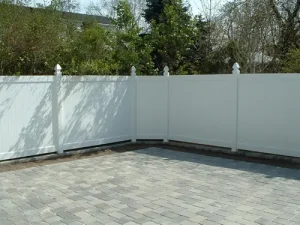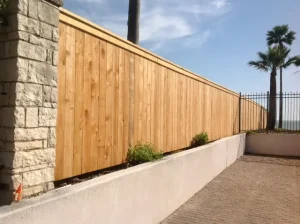![The Great Fence Debate Wood Versus Vinyl [How to Choose]](https://www.dcfence.com/wp-content/uploads/2024/04/The-Great-Fence-Debate-Wood-Versus-Vinyl-How-to-Choose-300x157.webp)
The Great Fence Debate: Wood Versus Vinyl [How to Choose?]
When it comes to enhancing the privacy, security, and aesthetic appeal of your home, few elements play as pivotal a role as your choice of

Balconies offer several advantages and are an essential feature for any modern home, providing extra living and storage space, refreshing views of the outdoors, and enhancing the aesthetic appeal of the building. In addition, they have a long history of being used to ornament both private homes and public buildings, serving practical purposes such as providing efficient exits or acting as breezeways.
Providing homeowners with tips for maximizing their balconies, a comprehensive guide covers the definition, history, importance of modern architecture, and best practices for utilizing them as part of one’s living space.
These balconies are attached to the building using cantilevers, which are beams attached to the building that extends outwards and support the balcony. Cantilevered balconies give the impression that they are floating in the air.
French balconies, also called Juliet balconies, are small balconies that do not have a platform to step out onto. Instead, they consist of a railing or a door that opens outward. French balconies are ideal for rooms without much space, as they provide the illusion of outdoor space without needing a platform.
False balconies, also called “faux balconies,” are decorative balconies that do not provide any outdoor space. False balconies are commonly used to add elegance or historical charm to a building’s facade.
As the name suggests, wraparound balconies wrap around the building’s exterior. These spacious balconies provide ample space for outdoor seating and dining, making them ideal for hosting get-togethers and relaxing.
Juliet balconies are small balconies extending out from a building but not providing any outdoor space. These balconies are often used for their aesthetic appeal and can add a touch of romance to any room’s decor.
Balconies can be made from various materials, each with distinct characteristics and benefits. Here are some of the most commonly used materials for balconies:
Designing a balcony involves several crucial factors that need to be considered. The purpose of the balcony is the first thing that needs to be considered, followed by the location and orientation that can impact the balcony’s functionality. Next, the size and shape of the balcony play an essential role in its usability and visual appeal. Finally, privacy and safety concerns must be considered during the design process to create a comfortable and secure space for the balcony’s users.
Balconies provide various benefits, including increased living space, improved air circulation, and natural lighting. However, the most significant advantage is their outdoor space, allowing for a small outdoor oasis for relaxation or entertaining guests. Furthermore, balconies provide beautiful views that can enhance the overall aesthetic of your living space.
Are you looking for creative ways to transform your balcony into an inviting and cozy haven? Check out these inspiring balcony decor ideas, whether sipping a cup of coffee or enjoying a book.
Adding furniture to your balcony can give it a comfortable and relaxing atmosphere. Some furniture examples are chairs, tables, benches, and even hammocks. In addition, you can choose items that are weather-resistant and lightweight.
Plants can turn your balcony into a green oasis. You can grow various plants, such as flowers, herbs, and vegetables. Use hanging baskets and wall-mounted or floor planters to maximize the space. Make sure to choose plants that can thrive in the sunlight and temperature of your balcony.
Balcony lighting can create a cozy ambiance after dark. You can use string lights, lanterns, candles, or even install permanent lighting. Choose lights that are weather-resistant and energy-efficient.
Personalize your balcony with rugs, cushions, blankets, and wall decor. You can add color and texture to your balcony through these items. Use your creativity and select items that match your style and personality.
Balcony safety measures are simple steps that we can take to avoid any mishaps. Installing fences and railings is crucial to secure the perimeter of the balcony. Maintaining them is necessary to minimize the chances of accidents.
Furthermore, overloading the balcony with too much weight is unsafe and can cause severe damage to the structure. Lastly, proper usage of balcony furniture is crucial. Ensuring furniture is placed strategically and securely prevents it from being a hazard.
Several factors can impact the cost of building a balcony, including the size and style of the balcony, the materials used, and whether or not it will require any structural modifications to your home. On average, the cost of building a balcony can range from a few thousand dollars to tens of thousands, depending on these factors. While the cost may seem high, a well-designed and constructed balcony can add value to your home.
Building codes and regulations play a crucial role in ensuring the safety of structures, especially balconies. Proper permits and inspections are necessary to ensure compliance with guidelines and guarantee the balcony’s strength and stability.
Legal considerations must also be considered, particularly regarding liability and potential lawsuits in case of injury or damage. Failure to adhere to building codes and regulations can jeopardize the integrity of balconies and pose a significant risk to users.
Balconies are a fundamental element of architectural styles and cultures across the globe. Let’s take a closer look at some of the unique and beautiful balconies that represent various cultures.
Mediterranean-style balconies are known for their intricate ironwork and bold colors. In addition, these balconies often feature ornate railings and are surrounded by lush greenery. Mediterranean balconies are designed to take advantage of the region’s mild weather and offer a comfortable outdoor space for relaxation and socializing.
In South Asian architecture, balconies are an essential feature of many buildings. The balconies usually consist of a simple balcony rail and offer views of the surrounding area. In addition, south Asian balconies are often used as open-air living spaces where people can relax, socialize or sleep.
Latin American-style balconies are characterized by their bold, bright colors and intricate ironwork. These balconies are typical in colonial-style buildings, especially in Havana and Cartagena. Latin American balconies often feature decorative railings and are frequently decorated with plants and flowers. They serve as an outdoor living spaces where people can enjoy the warm weather and watch street activities.
Throughout history and in many cultures, balconies have played a significant role. Some have become such iconic landmarks that they are revered worldwide. So, here are some of the most famous balconies you want to take advantage of.
1. The balcony at the Vatican: The balcony of Saint Peter’s Basilica in Vatican City is one of the most famous balconies in the world. From this balcony, the Pope delivers his Urbi et Orbi blessing on Christmas Day and Easter Sunday.
2. The Juliet balcony in Verona, Italy: The balcony at Casa di Giulietta in Verona, Italy, is believed to be the balcony featured in Shakespeare’s play Romeo and Juliet. The balcony overlooks a courtyard where visitors can leave love notes and messages.
3. The balcony at the Red Fort in Delhi, India: The balcony at the Red Fort in Delhi, India, is where the Prime Minister of India delivers the annual address to the nation on Independence Day. The balcony offers a commanding view of the fort’s main gate and the surrounding area.
Regular maintenance and cleaning are necessary for the longevity and safety of a balcony. Clean, sweep or vacuum daily and mop with soapy water once a week. Stubborn stains can be removed with a gentle cleaner and scrub brush. Regular maintenance checks include inspecting for cracks, loose railings, and structural issues, which a professional should fix.
To add greenery to your balcony, choose plants that can thrive in the available space, such as succulents, herbs, and small shrubs. Container gardening and vertical gardening are great options for creating a functional garden. Container gardening involves choosing a suitable container for your plants, while vertical gardening creates a living wall of plants that saves space and looks visually stunning.
Installing privacy screens is a great way to create a secluded outdoor living space. Additionally, incorporating tall plants in containers can provide a living barrier between you and your neighbors. For those looking for unique solutions, there are also creative options like hanging curtains or repurposing old shutters to create a rustic wall.
One way to achieve this is by incorporating furniture that serves multiple purposes and can be easily stowed away when unused. For example, foldable chairs and tables or even a compact bench with storage space can significantly maximize your available area. Additionally, decorating tricks such as adding mirrors, plants, and string lights can create an illusion of space and make the balcony feel more inviting.
Balconies are an excellent addition to any living space, providing a connection to the outdoors and creating a sense of openness and freshness.We hope that this ultimate guide to balconies has helped you in planning and creating your ideal outdoor space.
At D&C Fence Co., we understand the importance of building a safe and functional balcony that enhances your living space. We have years of experience designing, installing, and repairing balconies, and we are committed to providing our clients with top-quality services at affordable prices. Whether you need a new balcony or repair an existing one, we are here to help. Contact us today to schedule a consultation and assist you on how to build a balcony.
By submitting, you agree to receive emails from Uscreen and to our privacy policy.
![The Great Fence Debate Wood Versus Vinyl [How to Choose]](https://www.dcfence.com/wp-content/uploads/2024/04/The-Great-Fence-Debate-Wood-Versus-Vinyl-How-to-Choose-300x157.webp)
When it comes to enhancing the privacy, security, and aesthetic appeal of your home, few elements play as pivotal a role as your choice of

PVC (Polyvinyl Chloride) fencing is a type of synthetic plastic fence that offers a modern alternative to traditional materials like wood and metal. Distinguished by

Wood fences are one of the most traditional and versatile types of fencing used to delineate property lines, enhance privacy, and contribute to the aesthetic
Complete the form below and a representative will contact you shortly.